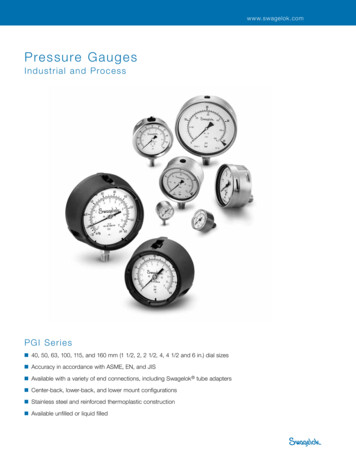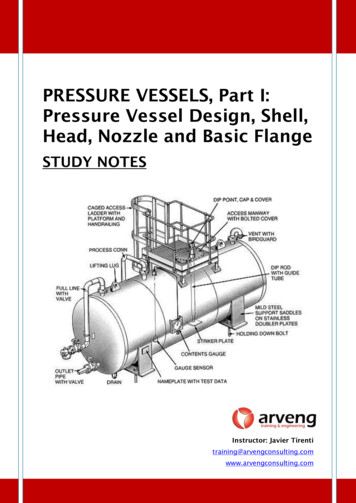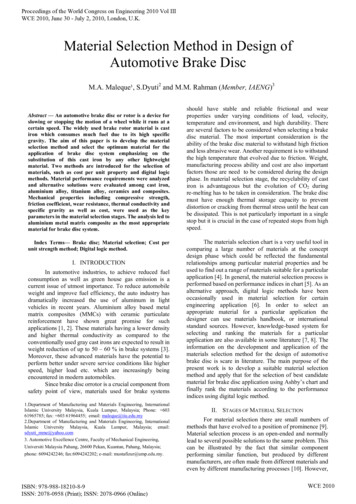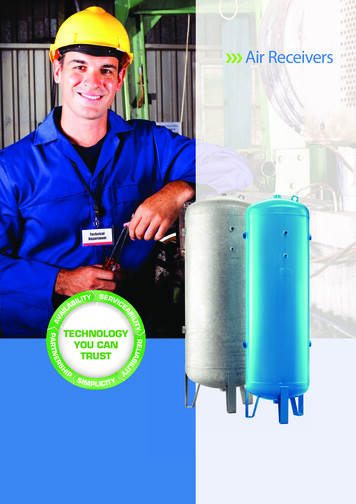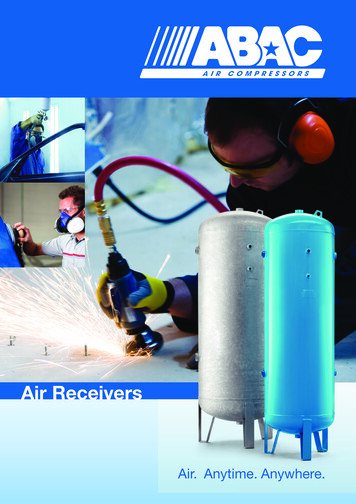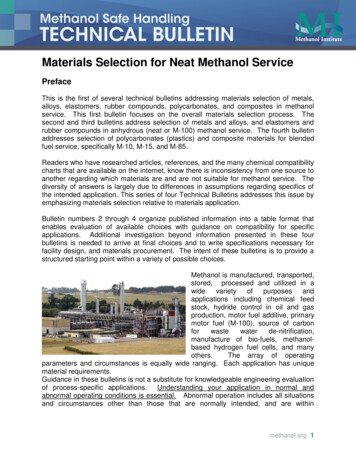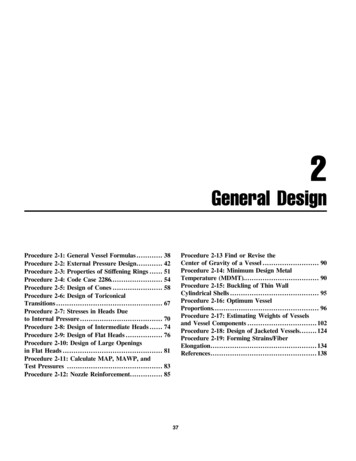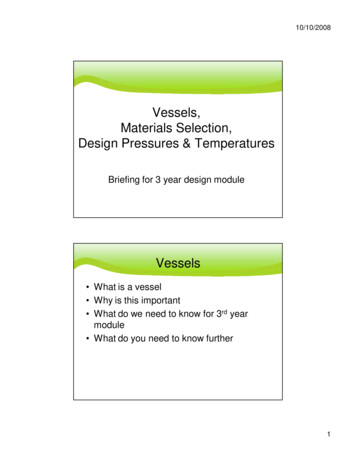
Transcription
10/10/2008Vessels,Materials Selection,Design Pressures & TemperaturesBriefing for 3 year design moduleVessels What is a vessel Why is this important What do we need to know for 3rd yearmodule What do you need to know further1
10/10/2008Diagram - Bob HeaslipCHEMECON – Vessel Input- All Dimensions should berounded (up usually) to the nearest6”-Then convert to M forCHEMECON2
10/10/2008Horizontal vs Vertical Packed Bed – Short circuitWhich do we want to use?Why Is Material SelectionImportant? Poor choices in materials selection havehistorically been a problem in process design– Has caused significant process hazards to occur– Has caused significant business interruption due topremature failures– Very expensive to fix later! Because it’s not part of the ‘fun’ part of processdesign it can often be relegated as anafterthought – one that can really come back tohaunt you.3
10/10/2008Why Is Material SelectionImportant? Engineers must ensure:– Equipment Life meets expectations of processlife– Failures do not occur - can cause significantloss of property and/or life– Contamination of product does not occur Chemical engineers must be aware of theissues so that the relevant informationmay be passed along to the specialistsWhy Worry? Corrosion Caused this Pipe Elbow to FailPublic report of the fire and explosion at the conocophilips humber refinery on16 April 2001By the Health and Safety s.pdf4
10/10/2008The Steps Who?– Chemical Engineers & Mechanical /Metallurgicalengineers How do you do it?––––Use knowledge/experience from prior systemsFundamental understanding of corrosion mechanismsTables of Material Selection / compatibilityrules of thumbSome Considerations Process fluids / materials – normal and upset– i.e. a plastic might be perfect for the fluidcorrosiveness, but will melt when the operators‘steam’ the equipment our during cleaning. Operating temperature and pressure, fluidvelocity Contamination of product Required life of the equipment– May choose to incur shorter life and replace moreoften Cost of the materials of construction (basematerial fabrication costs)5
10/10/2008Process Design For MaterialsSelection The Choices that the process engineer ismaking (i.e. fluids, temperature, pressure) areaffecting the materials selection. The Process Engineer can turn that thinkingaround:– Consider how you might change the process to allowfor a cheaper material selection Use concentrations that self passivate the surface Use other temp, press, compositions– Consider how you might minimize an expensivechoice in metallurgy – keep the piping short, make theequipment smaller,.General Types of Materials Carbon steel – strength & moderate corrosionresistance Low-alloy steels – strength at high temperatures Stainless steels – corrosion resistance Nickel alloys – corrosion resistance Copper alloys – sea water resistance Aluminum – light, low temperature toughness Titanium – sea water, chemical resistance Refractories – very high temperatures Non-metallics – aqueous corrosion & chemicals6
10/10/2008Chemical Resistance ChartsSource: Gormann Rupp Chemical Resistance Chart7
10/10/2008Failure Mechanisms FatigueBrittle FractureCreepCorrosion– General (even) corrosion– Localized corrosion Environmentally induced cracking– Chloride Stress Corrosion Cracking – aka Chloride Cracking - aka StressCorrosion Cracking High Temperature Hydrogen Attack (hydrogen embrittlement)Vessels - GeneralChart from:Turton et alBrittle Fracture-20 F8
10/10/2008Chloride Stress Corrosion Crackingin Stainless SteelPhoto: D. ModyCrevice CorrosionPhoto: D. Mody9
10/10/2008Stress Corrosion CrackingPhoto: D. ModyErrosionPhoto: D. Mody10
10/10/2008High Temperature HydrogenAttack Results from exposure to hydrogen atelevated temperatures & pressures. H reacts with carbides in steel to formmethane which cannot diffuse out. Methane pressure builds up, formingbubbles or cavities, microfissures andfinally fissures that combine to formcracks. Carbon & low-alloy steels are mostsusceptible.2211
10/10/20083rd year design moduleconsiderations There is Hydrogen gas present in our process Consider operating temperatures (maximum expected) Utilities: Ask yourself what utilities will be used.Heat Exchangers Rules of Thumb: Heat Exchanger tubes are usually SS (even ifCS could be used) allows for thinner steel to beused for better heat transfer.12
10/10/2008Sources of Information Definition: mil 1/1000 of an inch Sources of Corrosion tables information:– Analysis, Synthesis, and Design of Chemical Processes; Turtonet. al.; pg 170– Warren Rupp Pumps HON.pdf– Perry’s Chemical Engineers Handbook Only older editions provide corrosion tables Edition currently available through Queen’s Library online at Knovelno longer has material selection tables:– http://www.knovel.com/knovel2/Toc.jsp?BookID 48Vessels - General Wall Thickness– determined by required pressure Process Engineer Determines DesignPressureFabrication ShopProcess EngineerMaximum Allowable Working Pressure (MAWP)- ActualMetal Thickness UsedDesign Pressure (Relief Valve Set Pressures, MinimumRequired Metal Thickness)Maximum Op. Pressure (Controls, S/U , S/D .)Normal Op. Pressure (Simulator)13
10/10/2008Design Pressure Excessive design pressure causesequipment to be more expensive than isrequiredfor cylindrical shellstP riS EJ PChemEcon uses this for itspressure correction CcS Allowable Stress for the Materialt metal thickness, P Design PressureCc Corrosion Allowance, Ej Joint Efficiency5General - Design Temperatures Allowable Stress Values are dependant onTemperature Temperature at Design Pressure must bestated Materials become brittle below certaintemperatures - minimum design metaltemperature ChemEcon assumes moderatetemperatures14
10/10/20083rd Year Design Take Simulator Operating Pressure as Normal– Group equipment that is at same operating pressure– examples ? – Maximum OP. Pressure Normal 25 psi– Design Pressure lesser of 10% or 50 psi Maximum Operating PressureFabrication ShopProcess EngineerMaximum Allowable Working Pressure (MAWP)- ActualMetal Thickness UsedDesign Pressure (Relief Valve Set Pressures, MinimumRequired Metal Thickness) – Costing – CHEMECON ValueMaximum Op. Pressure (Controls, S/U , S/D .)Normal Op. Pressure (Simulator)3rd Year Design Keeping it SAFE! What occurs totemperatures if ReactorConversion increases?– What’s worst case?– What Material selection forworst case?– How can we avoid moreexpensive materials?15
10/10/2008Vessels - Safety A Vessel that can be isolatedrequires a Relief ValveVessels - Relief Valves16
Process Design For Materials Selection The Choices that the process engineer is making (i.e. fluids, temperature, pressure) are affecting the materials selection. The Process Engineer can turn that thinking around: –Consider how you might change the process t
